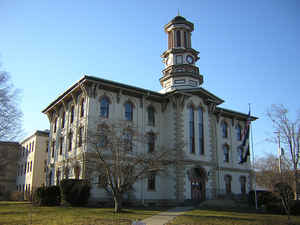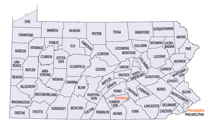Wyoming County, Pennsylvania
Wyoming County Education, Geography, and History

Wyoming County is a county located in the state of Pennsylvania. Based on the 2010 census, the population was 28,276. Its county seat is
Tunkhannock. It was created in 1842 from part of Luzerne County.
Wyoming County is included in the Scranton—Wilkes-Barre—Hazleton, PA Metropolitan Statistical Area.
Etymology - Origin of Wyoming County Name
Named for the Wyoming Valley. "Wyoming" is derived from an Indian word meaning "extensive meadows."
Demographics:
County QuickFacts: CensusBureau Quick Facts
Wyoming County History
Created on April 4, 1842, from part
of Luzerne County and named for the Wyoming Valley. "Wyoming" is derived from an
Indian word meaning "extensive meadows." Tunkhannock, the county seat was
incorporated as a borough on August 8, 1841, and was named for Tunkhannock
Creek. The creek's name means "small stream."
Wyoming shares with its mother county, Luzerne, the Wyoming Valley tradition of
the Connecticut claims, which began in 1754, and the Yankee-Pennamite wars. The
Trenton Decree (1782), its acceptance by Connecticut (1786), and the land
claimants' compensation statute (1807) ended the dispute. Although not part of
the geologically defined Wyoming Valley, which is in Luzerne County, Wyoming it
is one of four counties regarded as making up the historic Wyoming Valley.
Connecticut Yankees made up a large percentage of the early settlers. The area
experienced the settler exodus known as the Great Runaway following the Wyoming
Massacre (a Tory and Indian victory) in 1778. Lacking significant coal beds, the
county had primarily a lumber economy until 1900, which gave rise to a leather
tanning industry using hemlock bark. Leather manufacture continued after the
stands of hemlock were gone. The North Branch Canal passed through the area, and
Tunkhannock was on the Lehigh Valley and Nicholson on the D. L. & W. Railroads.
Grain and dairy farming gradually increased, and about 1900 dairying replaced
lumber as the major product. Also, quarrying, especially of Pennsylvania
bluestone, has been profitable. Tanneries used cattle hides and hemlock. The
Cyrus Avery Foundry made farm equipment. The absorbent papers unit of Procter
and Gamble, established at Mehoopany in 1966, is the county's biggest employer.
Presently, lumber and wood products, women's apparels, and shoes are other
products of this country. Farms cover 29 percent of the land, and dairy products
dominate agricultural production.
Geography: Land and Water
As reported by the Census Bureau, the county has a total area of 405 square miles (1,048 km2), of which, 397
square miles (1,029 km2) of it is land and 8 square miles (20 km2) of it (1.88%) is water.
Neighboring Counties
Bordering counties are as follows:
- Susquehanna County (north)
- Lackawanna County (east)
- Luzerne County (south)
- Sullivan County (west)
- Bradford County (northwest)
Education
Public school districts
Elk Lake School District (also in Susquehanna County)
Lackawanna Trail School District (also in Lackawanna County)
Lake-Lehman School District (also in Luzerne County)
Tunkhannock Area School District
Wyalusing Area School District (also in Bradford County)
Wyoming Area School District (also in Luzerne County)
Higher education
Keystone College (also in Lackawanna County)







